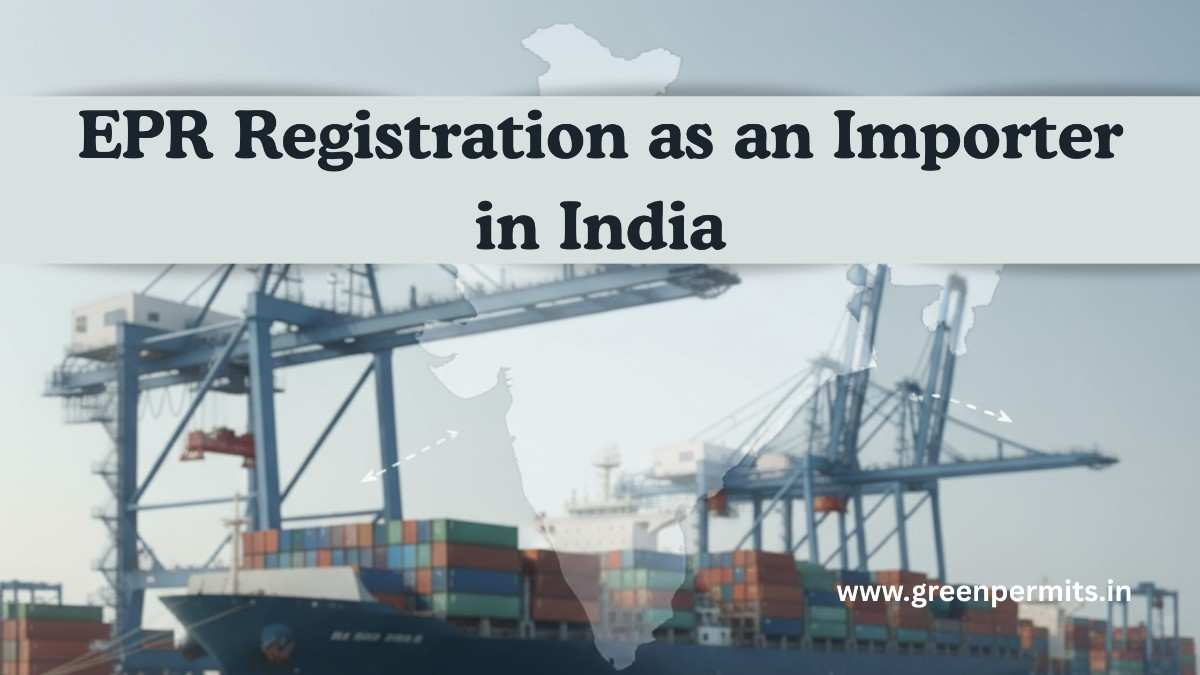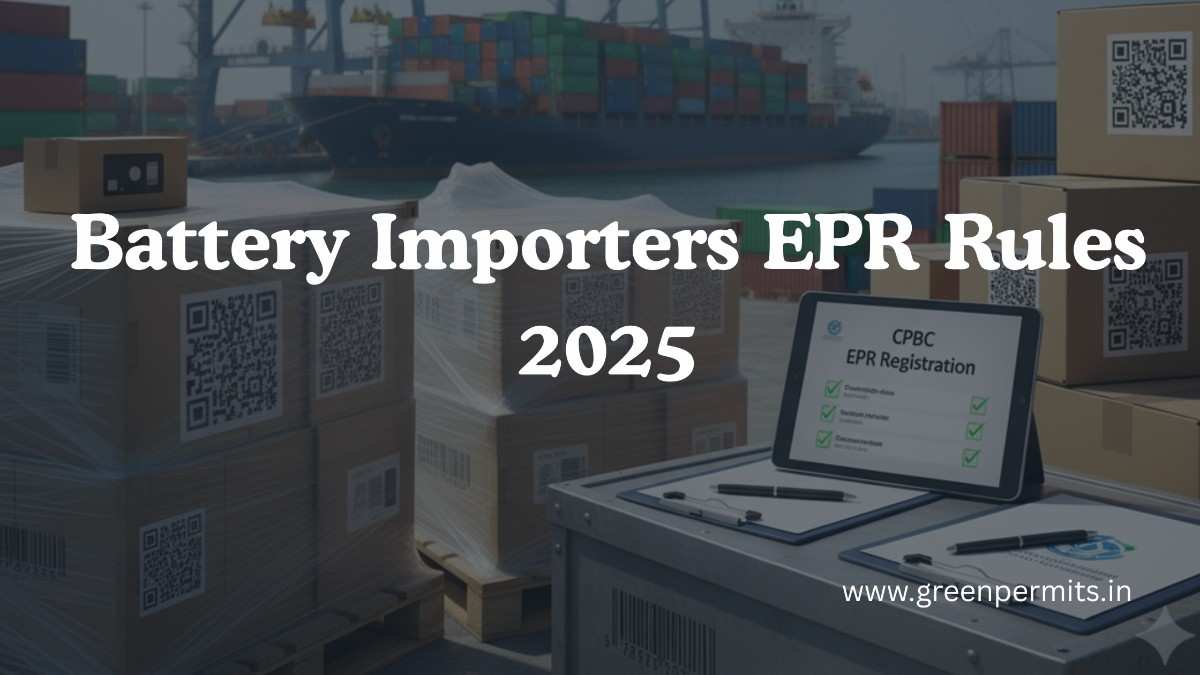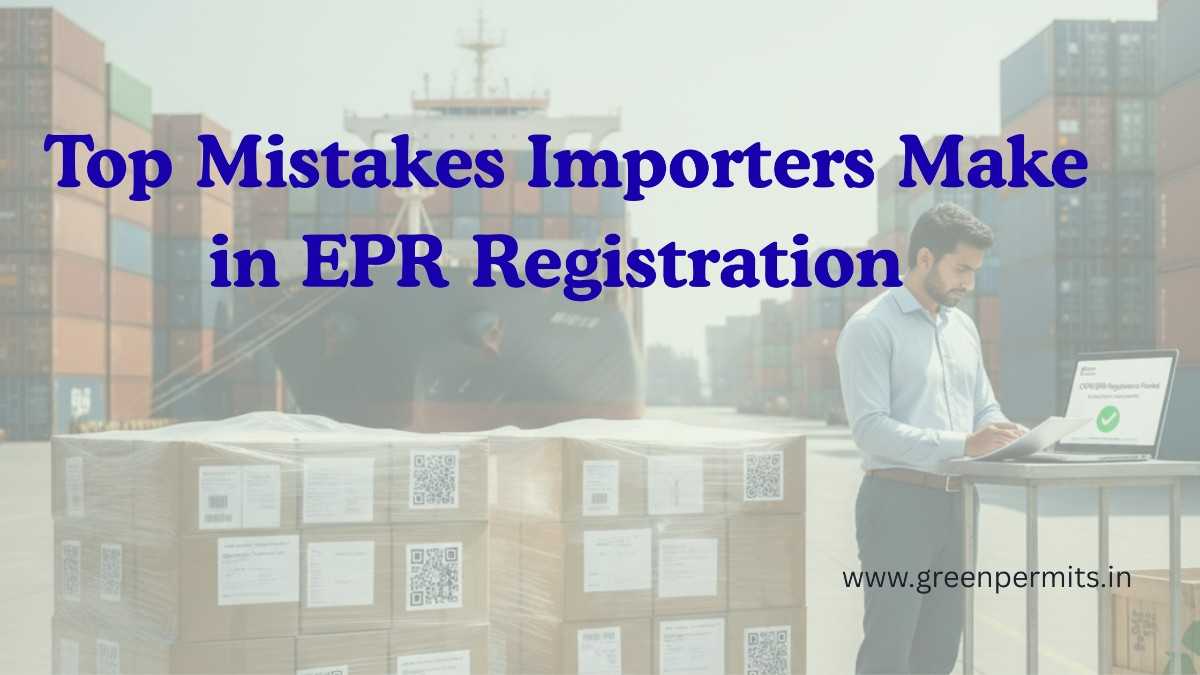Introduction: Why Importers Need to Act Now
Extended Producer Responsibility (EPR) is no longer optional for Indian importers. Whether you bring in electronics, plastic packaging, batteries, or packaged consumer goods, the rules now mandate registration on the CPCB EPR portal before you can legally import and sell in India.
From July 2025, every importer must ensure barcodes or QR codes linked to their EPR number are printed on packaging and product brochures. The Ministry of Environment, Forest and Climate Change (MoEFCC) has tightened enforcement under the E-Waste, Plastic Waste, and Battery Waste Management Rules.
If you are an importer, this guide gives you the step-by-step roadmap—covering documents, portal signup, fees, and return filing—so you can stay compliant, avoid penalties, and protect your business growth.
Who Needs EPR Registration as an Importer?
Any business that imports goods with plastic packaging, batteries, or electronic components into India must register as a “Producer” on the CPCB portal. This includes:
- Electronics importers (mobiles, laptops, appliances, accessories)
- Plastic packaging importers (bottles, sachets, wrappers, PET containers)
- Battery importers (lithium-ion, lead acid, EV batteries, button cells)
- Packaged goods importers (food, beverages, FMCG with plastic packaging)
- Foreign brands selling in India through dealers or distributors
Even if you don’t manufacture locally, importing finished goods makes you liable under EPR.
Step-by-Step Process for Importers
Step 1 — Gather Mandatory Documents
Before creating an account on the EPR portal, prepare the following:
- Import Export Code (IEC) issued by DGFT
- GST Registration Certificate
- PAN of the company and authorized person
- CIN / Incorporation Certificate (if registered under MCA)
- Consent/Authorizations (only if you also have storage/assembly facilities in India)
- Product details — HS codes, categories (EEE, plastic, battery), quantities placed in market
- CA Certificate certifying import data (sales/import weight in MT)
- Board Resolution / Authorization Letter for the signatory
Step 2 — Portal Sign-Up
Visit the CPCB’s EPR portals depending on your product category:
- E-Waste: eprewastecpcb.in
- Plastic Waste: cpcbeprplastic.in
- Battery Waste: eprbatterycpcb.in
Create your login credentials using company email, mobile OTP, and IEC/GST details.
Step 3 — Submit Application
Once logged in, fill your application in parts:
- General Information: company name, registered address, IEC/GST/PAN
- Authorized Person Details: name, designation, mobile, email, PAN, Aadhaar
- Product Information: select categories (EEE, plastic packaging, batteries), sales/import data year-wise
- EPR Targets: portal auto-calculates based on past sales/imports and product life cycle
- Upload Documents: GST, PAN, IEC, CA certificate, covering letter, RoHS declaration (for electronics)
- Payment of Fees: based on category and slab (see below)
Step 4 — Pay Fees
CPCB charges depend on waste category and sales/import volume.
E-Waste Importer / Producer Fee Slabs
- <50 MT: ₹2,500
- 50–100 MT: ₹7,500
- 100–1,000 MT: ₹1,50,000
- 1,000–5,000 MT: ₹10,00,000
- 5,000 MT: ₹15,00,000
Battery Importer Fee (Turnover-Based)
- <₹5 Cr turnover: ₹10,000
- ₹5–50 Cr turnover: ₹20,000
- ₹50 Cr turnover: ₹40,000
Plastic Importer Fee
- <1,000 TPA: ₹10,000
- 1,000–10,000 TPA: ₹20,000
- 10,000 TPA: ₹50,000
Annual Maintenance Charge: ₹5,000 for all entities
Step 5 — CPCB Review & Approval
- CPCB checks documents within 30 working days
- Incomplete applications → queries raised, 7 days to respond
- Approval issued as digital registration certificate (valid for 5 years)
Step 6 — Print Barcode / QR (From 2025 Amendments)
- Plastic packaging: Barcode/QR with EPR registration number mandatory from 1 July 2025
- Batteries: Barcode/QR with EPR registration number mandatory from 24 February 2025
Importers must ensure foreign suppliers print these on packaging before export.
Step 7 — Return Filing
- Quarterly Returns: upload sales/imports and recycling certificates
- Annual Returns: submit detailed compliance report by 30 June of following year
- Failure to file → CPCB may suspend registration and impose fines
Comparison Table: Importer vs Producer vs Brand Owner vs Recycler
| Entity | Authority | Fees | Obligations | Validity |
|---|---|---|---|---|
| Importer | CPCB (if >2 states) / SPCB (≤2 states) | ₹2,500 – ₹15L (EEE), turnover slabs for batteries, TPA slabs for plastics | Register IEC, print barcode/QR, file quarterly & annual returns | 5 years |
| Producer | CPCB | Same as importer | Register brand + products, awareness plan, meet recycling targets | 5 years |
| Brand Owner | CPCB / SPCB | ₹10k – ₹50k (plastics) | Ensure packaging waste collected via PWPs | 1–3 years |
| Recycler | CPCB / SPCB | ₹15,000 (registration), AMC ₹5,000 | Issue EPR certificates against actual recycling | 5 years |
Checklist for Importers
- IEC, GST, PAN, CIN ready
- Register on CPCB EPR portal
- Upload product category & import data
- Pay registration fee as per slab
- Obtain EPR certificate (valid 5 years)
- Ensure packaging has barcode/QR (from 2025)
- File quarterly & annual returns
- Maintain agreements with authorized recyclers
Case Study: How a Foreign Importer Saved Penalties
A Singapore-based electronics company importing laptops into India applied for EPR in late 2024. Their average annual import was 80 MT of EEE, putting them in the ₹7,500 fee slab.
By registering before the July 2025 barcode deadline, they avoided shipment delays at customs and secured their CPCB certificate in 28 days. They also tied up with an authorized recycler in Delhi, ensuring smooth return filings across 5 states.
Penalties & Enforcement
- Non-registration: imports can be stopped at ports
- Non-filing of returns: suspension of certificate until compliance
- Barcode/QR missing after deadlines: fines and possible seizure of goods
- Misreporting: registration may be revoked for 1 year
FAQs
Depends on waste type — ₹2,500–₹15L (EEE by weight), ₹10k–₹40k (batteries by turnover), ₹10k–₹50k (plastics by TPA).
Yes. Each waste stream has its own CPCB portal. Multi-category importers must register under all applicable rules.
You still need Plastic EPR registration as a PIBO, since packaging enters the Indian market.
Delayed or missed returns can lead to suspension of registration, financial penalties, and restrictions on imports.
If you operate in ≤2 states, SPCB grants registration; if >2 states, CPCB handles it. SPCBs may also inspect storage facilities.
Technically no. Customs may clear consignments, but CPCB can penalize you later. Best practice: secure EPR before imports.
Conclusion
EPR compliance is no longer just for large manufacturers. Importers are now in the spotlight—with barcoding, quarterly returns, and stricter CPCB oversight.
If you’re an importer of electronics, batteries, plastics, or packaged goods, the time to act is now.
Green Permits Consulting can help you navigate the entire importer registration process — from documentation and portal filing to barcode compliance and return filing.
Email: wecare@greenpermits.in
Mobile: +91 78350 06182









